External links
- The Interactive NGC Catalog Online: NGC 2064
- NASA/IPAC Extragalactic Database: NGC 2064
-
 Media related to NGC 2064 at Wikimedia Commons
Media related to NGC 2064 at Wikimedia Commons
| Reflection nebula | |
|---|---|
| Observation data: J2000.0 epoch | |
| Right ascension | 05h 46m 18.4s [1] |
| Declination | 00° 00′ 21″ [1] |
| Apparent dimensions (V) | 1.0' x 1.0' [1] |
| Constellation | Orion |
| Designations | LBN 1627 |
NGC 2064 is a reflection nebula in the constellation Orion. It was discovered on January 11, 1864 by Heinrich d'Arrest. [1] It is part of a group of nebulae, that also includes Messier 78, NGC 2071 and NGC 2067.

The New General Catalogue of Nebulae and Clusters of Stars is an astronomical catalogue of deep-sky objects compiled by John Louis Emil Dreyer in 1888. The NGC contains 7,840 objects, including galaxies, star clusters and emission nebulae. Dreyer published two supplements to the NGC in 1895 and 1908, known as the Index Catalogues, describing a further 5,386 astronomical objects. Thousands of these objects are best known by their NGC or IC numbers, which remain in widespread use.
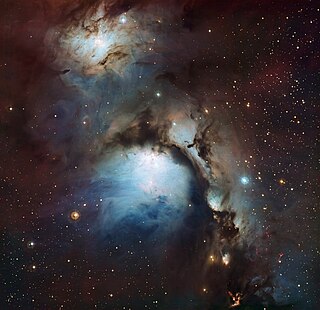
Messier 78 or M78, also known as NGC 2068, is a reflection nebula in the constellation Orion. It was discovered by Pierre Méchain in 1780 and included by Charles Messier in his catalog of comet-like objects that same year.
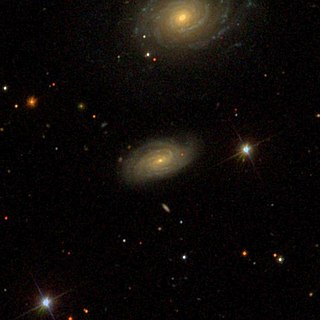
NGC 2 is a spiral galaxy in the constellation Pegasus, discovered by Lawrence Parsons, 4th Earl of Rosse on 20 August 1873, and was described as "very faint, small, south of NGC 1." It lies slightly to the south of NGC 1. It is a faint spiral galaxy of apparent magnitude 14.2.

NGC 147 is a dwarf spheroidal galaxy about 2.58 Mly away in the constellation Cassiopeia. NGC 147 is a member of the Local group of galaxies and a satellite galaxy of the Andromeda Galaxy (M31). It forms a physical pair with the nearby galaxy NGC 185, another remote satellite of M31. It was discovered by John Herschel in September 1829. Visually it is both fainter and slightly larger than NGC 185. This means that NGC 147 is more difficult to see than NGC 185, which is visible in small telescopes. In the Webb Society Deep-Sky Observer's Handbook, the visual appearance of NGC 147 is described as follows:
Large, quite faint, irregularly round; it brightens in the middle to a stellar nucleus.

NGC 246 is a planetary nebula in the constellation Cetus. The nebula and the stars associated with it are listed in several catalogs, as summarized by the SIMBAD database. It is roughly 1,600 light-years away. The nebula's central star is the 12th magnitude white dwarf HIP 3678.
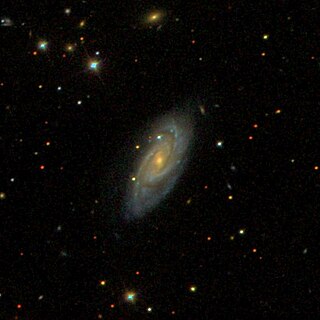
NGC 21 is a spiral galaxy in the Andromeda constellation. It was discovered by William Herschel in 1790. Lewis Swift observed it again in 1885, leading to its double listing in the New General Catalogue.

The New General Catalogue objectNGC 48 is a barred spiral galaxy located approximately 79.3 million light-years from the Solar System in the constellation Andromeda.

NGC 474 is an elliptical galaxy about 100 million light years distant in the constellation Pisces. This large galaxy is known to possess tidal shells and tidal tails, although their origins remain unclear. One possible explanation is that NGC 474 interacted with a galaxy several billion years ago.
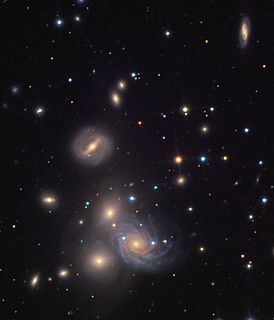
NGC 67 is an elliptical galaxy located in the constellation Andromeda that was discovered on October 7, 1855 by R. J. Mitchell, who described it as "extremely faint, very small, round". The galaxy belongs to the NGC 68 group, which also contains the galaxies NGC 68, NGC 69, NGC 70, NGC 71, NGC 72, and possibly NGC 74.

NGC 68 is a lenticular galaxy, and the central member of the NGC 68 group, in the constellation Andromeda. The galaxy was discovered on September 11, 1784, by William Herschel, who observed the NGC 68 group as a single object and described it as "extremely faint, large, 3 or 4 stars plus nebulosity". As such, his reported location is between NGC 68, NGC 70, and NGC 71. By the time Dreyer looked at the galaxies to add to the NGC catalog, however, he was able to tell that the single galaxy observed by Herschel was in fact 3 adjacent galaxies, and cataloged them as NGC 68, NGC 70, and NGC 71.

NGC 201 is a spiral galaxy in the constellation of Cetus. It is one of the group members of HCG 7, with the other group members NGC 192, NGC 196, and NGC 197. It was discovered on December 28, 1790 by William Herschel.

NGC 156 is a double star located in the Cetus constellation. It was discovered on 1882 by Ernst Wilhelm Leberecht Tempel.

NGC 375 is an elliptical galaxy located in the constellation Pisces. It was discovered on September 12, 1784 by William Herschel. It was described by Dreyer as "pretty faint, small, round, brighter middle." Along with galaxies NGC 379, NGC 380, NGC 382, NGC 383, NGC 384, NGC 385, NGC 386, NGC 387 and NGC 388, NGC 375 forms a galaxy cluster called Arp 331.

NGC 380 is an elliptical galaxy located in the constellation Pisces. It was discovered on September 12, 1784 by William Herschel. It was described by Dreyer as "pretty faint, small, round, suddenly brighter middle." Along with galaxies NGC 375, NGC 379, NGC 382, NGC 383, NGC 384, NGC 385, NGC 386, NGC 387 and NGC 388, NGC 380 forms a galaxy cluster called Arp 331.
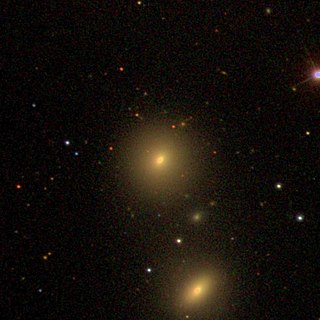
NGC 385 is an unbarred lenticular galaxy located in the constellation Pisces. It was discovered on November 4, 1850 by Bindon Stoney. It was described by Dreyer as "pretty faint, pretty small, round, northeastern of 2.", the other being NGC 384. Along with galaxies NGC 375, NGC 379, NGC 382, NGC 383, NGC 384, NGC 386, NGC 387 and NGC 388, NGC 385 forms a galaxy cluster called Arp 331.
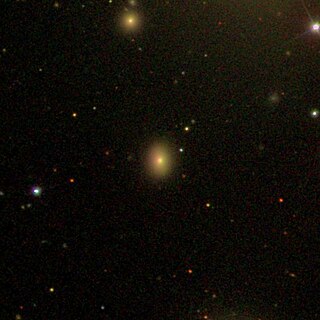
NGC 386 is an elliptical galaxy located in the constellation Pisces. It was discovered on November 4, 1850 by Bindon Stoney. It was described by Dreyer as "considerably faint, small, round." Along with galaxies NGC 375, NGC 379, NGC 382, NGC 383, NGC 384, NGC 385, NGC 387 and NGC 388, NGC 386 forms a galaxy cluster called Arp 331.

NGC 490, also occasionally referred to as PGC 4973 or GC 277, is a lenticular galaxy in the constellation Pisces. It is located approximately 85 million light-years from Earth and was discovered on December 6, 1850, by Irish engineer Bindon Blood Stoney. Although John Dreyer, creator of the New General Catalogue, credits the discovery to astronomer William Parsons, he notes that many of his claimed discoveries were made by one of his assistants. In the case of NGC 490, the discovery was made by Bindon Stoney, who discovered it along with NGC 486, NGC 492 and NGC 500 during his observation of NGC 488.

NGC 2071 is a reflection nebula in the constellation Orion. It was discovered on January 1, 1784, by William Herschel. It is part of a group of nebulae that also includes Messier 78, NGC 2064, and NGC 2067.

NGC 2067 is a reflection nebula in the constellation Orion. It was discovered in 1876 by Wilhelm Tempel. It is part of a group of nebulae that also includes Messier 78, NGC 2071 and NGC 2064.